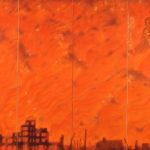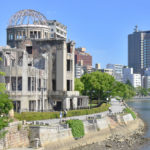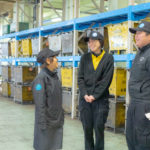Column 7 From the A-Bomb Experience to Nuclear Abolition
by Hiroshi Harada
The Hiroshima Peace Memorial Museum which was under comprehensive renovation reopened its Main Building in the spring of 2019. Neatly displayed are the clothes that the victims (hibakusha) had on at the time of the dropping of the atomic bomb. Who can imagine that those clothes were those of young children, students, young women and workers, who were all well alive that day? And who can imagine what have become of them in that instant of unimaginable heat, wind, and radiation?
Many people who were within the two- kilometer radius which became a total incineration and destruction zone, died instantly. The few who managed to survive stumbled through the city that had turned into hell, not knowing what had happened to themselves, seeking to escape in fear from the raging fire that immediately followed the blast. Countless numbers of people were burnt alive under collapsed buildings. Thoroughly destroyed buildings unable to provide shelter under the relentless August sun, during the hottest season of the year, the stench of rotting human flesh filled the air. There was no one around to help the gravely wounded, barely able to breathe, while their skin melted away. Almost all of the doctors and nurses who used to work in the city also died, and little medicine were available.
By the end of 1945, nearly 140,000 out of 350,000 residents of Hiroshima at that time died: this was the consequence of just one atomic bomb with a diameter of 70 cm and 3 meters long. There are 70,000 anonymous souls whose names yet unknown that lay in peace to this day under the Atomic Bomb Memorial Mound at the Hiroshima Peace Memorial Park. The 814 individuals whose names have been identified remain unclaimed. From that day on, bodies upon bodies of the victims were piled up in parks and schoolyards around the city to be incinerated, while survivors did everything within their power to survive.
With the end of the war fast approaching, firebombs rained down throughout Japan, turning the land into a vast burnt field. Most of the Japanese citizens were worn out, in dire straits. Very little relief and emergency goods reached the people of Hiroshima who lost everything including food, clothing, and shelter. Having lost their history, culture, local communities and physically and mentally deeply wounded, the people of Hiroshima had to yet endure the fear of the after-effects of the radiation, which brought on unbearable discrimination amongst them. Although there are 12,000 survivers alive who were in the total incineration and destruction zone at the time of the blast, many of them have locked up their memories of that day together with the impact of the mass power of destruction of the bomb that they experienced in that midsummer heat.
Ever since then, Hiroshima has become to be known as the first city in human history to experience the dropping of the atomic bomb. Today, not only the city of Hiroshima but also the Japanese government, Hiroshima prefecture, respective organizations, educational institutions, and the media are all voicing out the message of “peace.” But wouldn’t a peace movement that does not have an A-bomb experience at its core be nothing but a one-off event? Many of the opinions and recommendations wind up being forgotten by both the ones who do the talking, and the ones that do the listening: the government does little to verify the effect of these events.
No matter how many words, images, data, or painstaking research papers are being used, exhibits and researches that do not pay heed to the voices of the hibakusha nor reveal the truth about their experiences, as well as storytelling activities on behalf of the experiences and voices of the hibakusha all ring hollow to me. As the experiences are too painful to talk about, and also too painful to listen to, the storytellers can “narrate”the stories but cannot truly and fully convey the quintessence of the whole picture.
Last November, while his visit to Hiroshima, Pope Francis issued a powerful message during his attendance to the “Meeting for Peace” held at the Hiroshima Peace Memorial Park, calling out to the world that “the use of atomic energy for purposes of war is today, more than ever, a crime,” and said: “How can we propose peace if we constantly invoke the threat of nuclear war as a legitimate recourse for the resolution of conflicts?”
38 years ago, at the same Hiroshima Peace Memorial Park, Pope John Paul II stated that, “to remember Hiroshima is to abhor nuclear war. To remember Hiroshima is to commit oneself to peace.” Those words were deeply embedded in the souls of the people, and have supported the peace movement ever since.
75 years have passed since the dropping of the bombs, yet the United States and other eight countries possess nuclear weapons only to threat one another. Our instinct tells us, however, that there is no winner or loser in a state of nuclear war, and that nuclear war means the end of humanity all together.
How can we pass along the experience and the realities of the damage, and keep all this from eroding away when the hibakusha are aging and passing away? When the hibakusha will no longer be with us, what and who will be there to show the impact of the bomb and its devastating consequences to the future? Could it not be the trees and the buildings that were struck by the blast, rather than the storytellers? The Hiroshima Peace Memorial Park, close to ground zero, was once crowed with tailors, photograph studios, hotels, hospitals, shrines and temples, which were all destroyed in a flash on that day still remain buried even today underground. Together with the Atomic Bomb Dome which was designated as a World Heritage Site, historical sites such as the Honkawa Elementary School, the Bank of Japan branch office, the Hiroshima Rikugun Hifuku Shisho (Army Clothing Depot) survived the blast and remain to remind us of the devastation which the bomb caused. These facilities were places which many victims on the verge of death were taken to but receiving little to no care that day, and pass on the message of the scars from the bomb, as well as the history of Hiroshima as once being a military city. I strongly believe that these buildings and trees that managed to survive the blast and its aftermath will continue to tell their stories, even after no hibakusha will be here with us to tell their stories.
The Treaty on the Prohibition of Nuclear Weapons which was adopted in 2017 has yet to be ratified by 50 nations. The position of the Japanese Government, which is turning its back on this treaty even as it claims to be the only country that has suffered the devastation of the atomic bomb, must appear confusing to the rest of the world. It is time for not only the Japanese citizens, but also the 1.3 billion Catholics, together with every citizens of the world, and particularly national leaders, to consider their respective answers and solutions to the message posed by Pope Francis in Hiroshima. Mentioning words such as “peace” and “nuclear threat” is easy; what is more important is how each and every one acts. If those who love our beautiful, irreplaceable Earth, our dear ones, our lives, our peaceful day-to-day existence do not act to eliminate nuclear weapons, then who will?
Mr. Hiroshi Harada, Former director in charge of international affairs and peace (served simultaneously as director of Hiroshima Peace Memorial Museum)







